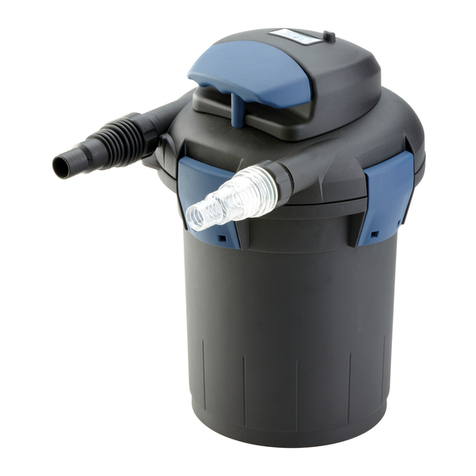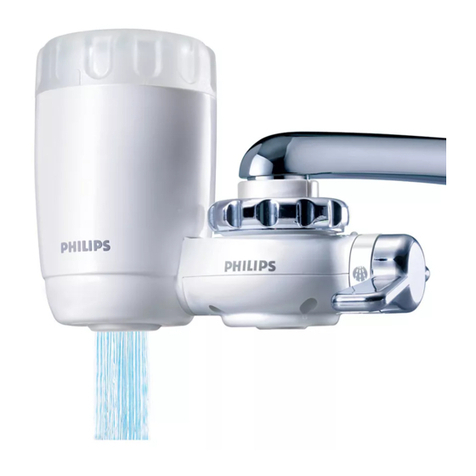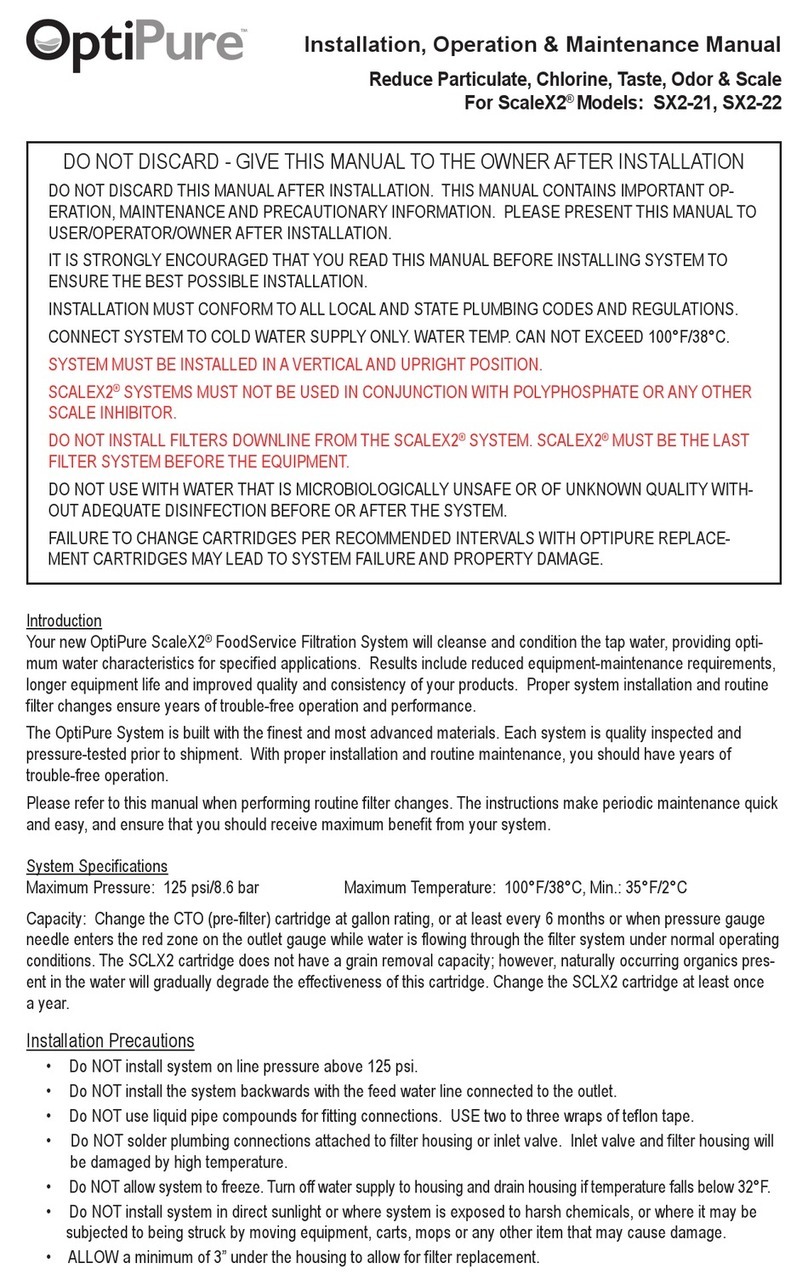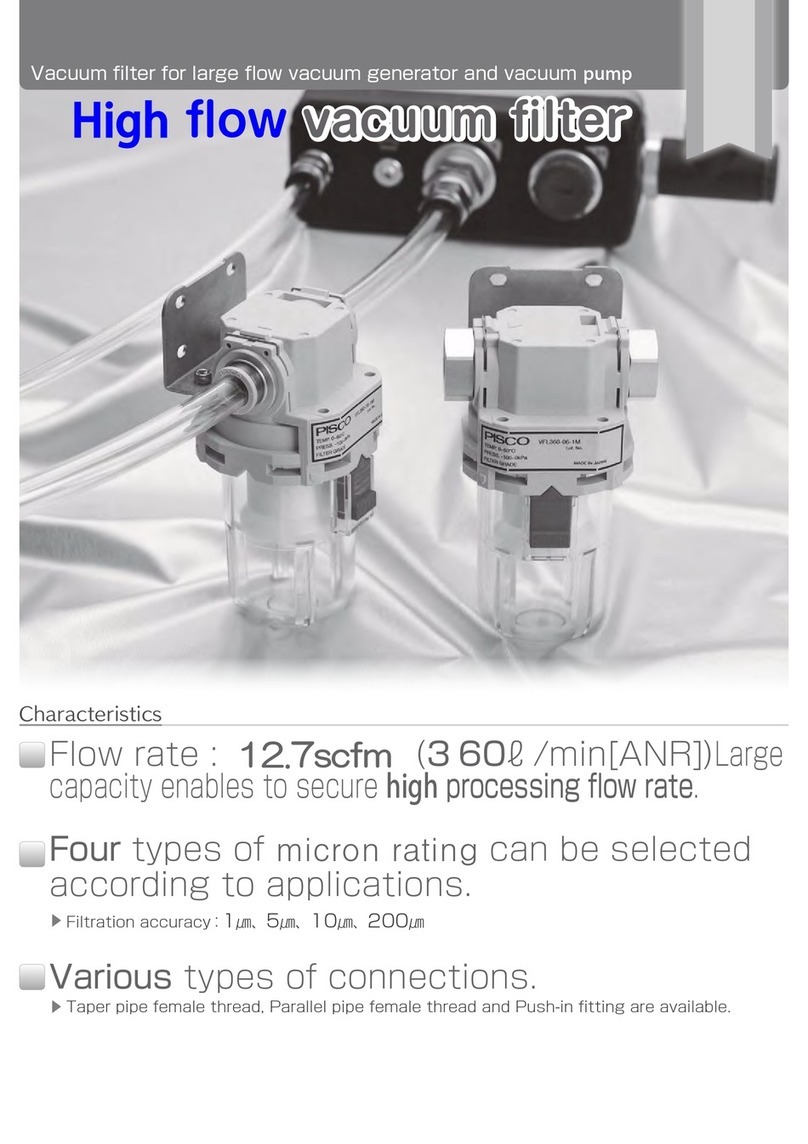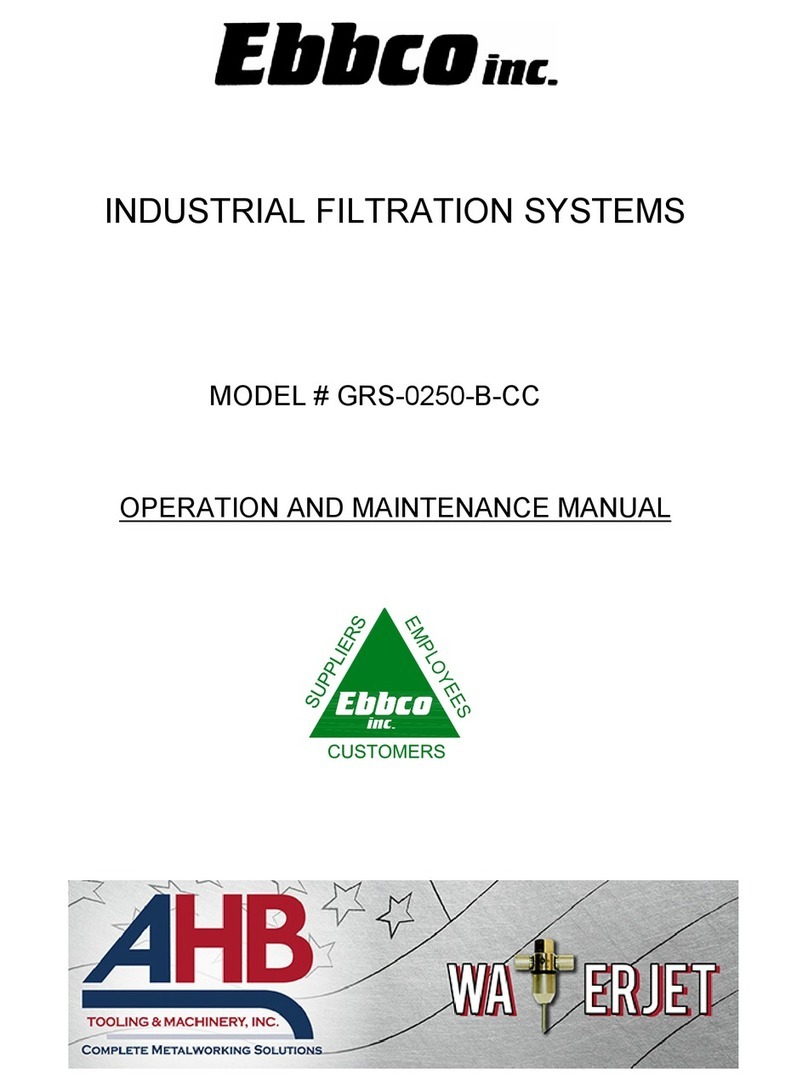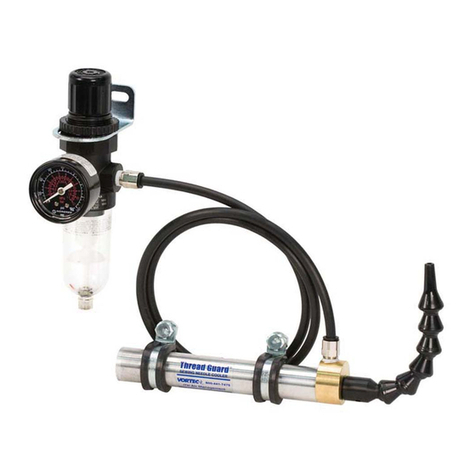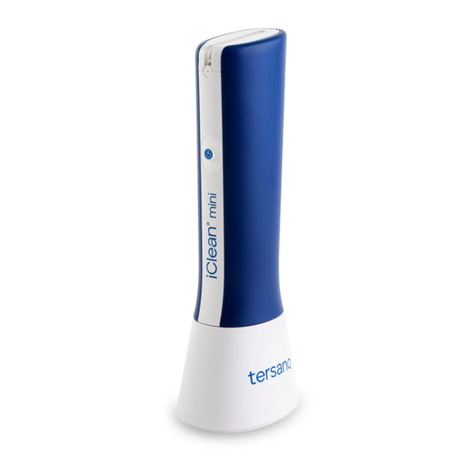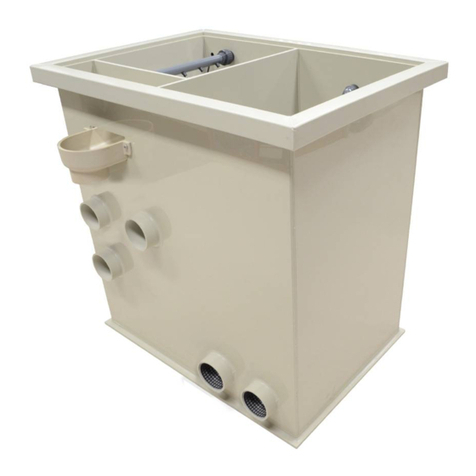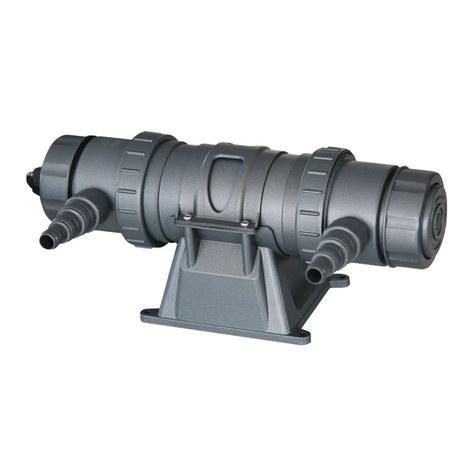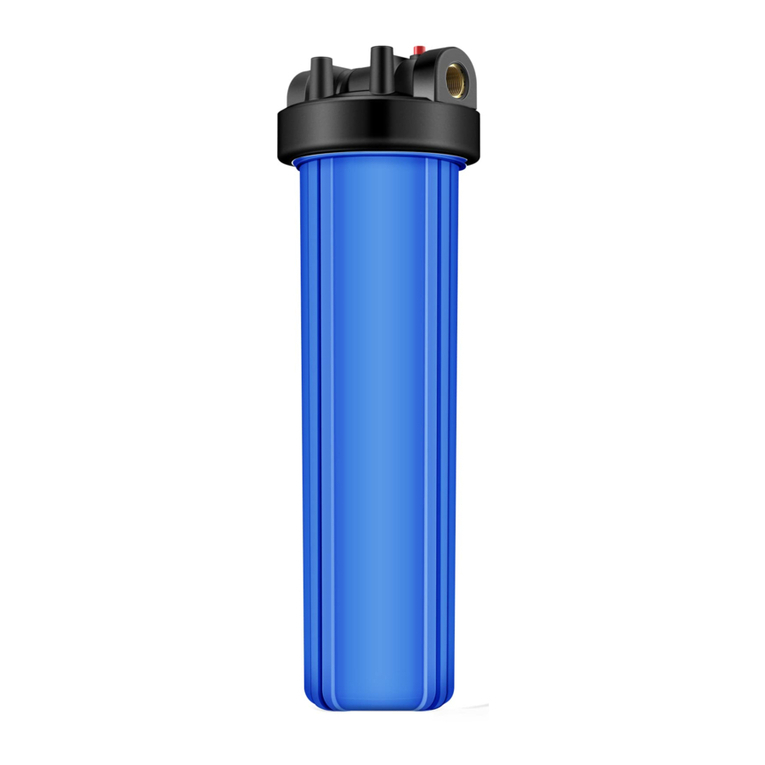Neptun Premium NPTF-O 15000 User manual

NPTF-O 15000
DE Gebrauchsanleitung
GB Operating instructions
FR Notice d‘emploi
IT Istruzioni d‘uso
ES Instrucciones de uso
NL Gebruiksaanwijzing
PL Instrukcja użytkowania
CZ Návod k použití
SK Návod na použitie
HU Használati útmutató
SI Navodila za uporabo
HR Uputa o upotrebi
BG Упътване за употреба
RU Руководство по
эксплуатации
DK Brugsanvisning
NO Brugsanvisning
SE Brugsanvisning
FI Käyttöohje
23313 GA Neptun NPTF-O 15000_end.indd 123313 GA Neptun NPTF-O 15000_end.indd 1 24.01.14 09:2324.01.14 09:23

- -
2
A
BST0001
B
BST0002

- -
3
C
BST0003

- -
4
D
BST0004

- DE -
- DE -
5
- DE -
Original Gebrauchsanleitung
WARNUNG
Dieses Gerät kann von Kindern ab 8 Jahren und darüber sowie von
Personen mit verringerten physischen, sensorischen oder mentalen
Fähigkeiten oder Mangel an Erfahrung und Wissen benutzt werden,
wenn sie beaufsichtigt oder bezüglich des sicheren Gebrauchs des
Gerätes unterwiesen wurden und die daraus resultierenden
Gefahren verstehen.
Kinder dürfen nicht mit dem Gerät spielen.
Reinigung und Benutzerwartung dürfen nicht von Kindern ohne
Beaufsichtigung durchgeführt werden.
Das Gerät muss über eine Fehlerstrom-Schutzeinrichtung mit einem
Bemessungsfehlerstrom von maximal 30 mA abgesichert sein.
Gerät nur anschließen, wenn die elektrischen Daten von Gerät und
Stromversorgung übereinstimmen. Die Gerätedaten befinden sich
auf dem Typenschild am Gerät, auf der Verpackung oder in dieser
Anleitung.
Tod oder schwere Verletzungen durch Stromschlag sind möglich!
Bevor Sie ins Wasser greifen, alle elektrischen Geräte im Wasser
vom Stromnetz trennen.
Gerät nicht verwenden, wenn elektrische Leitungen oder Gehäuse
beschädigt sind.
Eine beschädigte Anschlussleitung kann nicht ersetzt werden. Gerät
entsorgen.
Gerät nur betreiben, wenn sich keine Personen im Wasser aufhalten.
SICHERHEITSHINWEISE
Vorschriftsmäßige elektrische Installation
Elektrische Installationen müssen den nationalen Errichterbestimmungen entsprechen und dürfen nur von einer
Elektrofachkraft vorgenommen werden.
Eine Person gilt als Elektrofachkraft, wenn sie auf Grund ihrer fachlichen Ausbildung, Kenntnisse und Erfahrungen
befähigt und berechtigt ist, die ihr übertragenen Arbeiten zu beurteilen und durchzuführen. Das Arbeiten als Fachkraft
umfasst auch das Erkennen möglicher Gefahren und das Beachten einschlägiger regionaler und nationaler Normen,
Vorschriften und Bestimmungen.
Bei Fragen und Problemen wenden Sie sich an eine Elektrofachkraft.
Verlängerungsleitungen und Stromverteiler (z. B. Steckdosenleisten) müssen für die Verwendung im Freien geeignet
sein (spritzwassergeschützt).
Steckerverbindungen vor Feuchtigkeit schützen.
Gerät nur an einer vorschriftsmäßig installierten Steckdose anschließen.

- DE -
- DE -
6
Sicherer Betrieb
Der Sicherheitsabstand des Gerätes zum Wasser muss mindestens 2 m betragen.
Gerät nicht an der elektrischen Leitung tragen oder ziehen.
Leitungen geschützt vor Beschädigungen verlegen und darauf achten, dass niemand darüber fallen kann.
Gehäuse des Gerätes oder zugehöriger Teile nur öffnen, wenn in dieser Anleitung ausdrücklich dazu aufgefordert
wird.
Niemals technische Änderungen am Gerät vornehmen.
Am Gerät nur Arbeiten durchführen, die beschrieben sind.
Nur Original-Ersatzteile und -Zubehör für das Gerät verwenden.
Das Gerät, Anschlüsse und Stecker sind nicht wasserdicht und dürfen nicht im Wasser verlegt bzw. montiert werden.
Halten Sie die Steckdose und den Netzstecker trocken.
Betreiben Sie das Gerät nur mit der im Lieferumfang enthaltenen Filterpumpe.
Der Filter darf in keinem Fall überlaufen. Es besteht die Gefahr der Teichentleerung.
Über diese Gebrauchsanleitung
Mit dem Kauf des Produkts NPTF-O 15000 haben Sie eine gute Wahl getroffen.
Lesen Sie vor der ersten Benutzung des Gerätes die Anleitung sorgfältig und machen Sie sich mit dem Gerät vertraut.
Alle Arbeiten an und mit diesem Gerät dürfen nur gemäß der vorliegenden Anleitung durchgeführt werden.
Beachten Sie unbedingt die Sicherheitshinweise für den richtigen und sicheren Gebrauch.
Bewahren Sie diese Anleitung sorgfältig auf. Bei Besitzerwechsel geben Sie bitte die Anleitung weiter.
Warnhinweise
Die Warnhinweise in dieser Anleitung sind durch Signalworte klassifiziert, die das Ausmaß der Gefährdung anzeigen.
WARNUNG
Bezeichnet eine möglicherweise gefährliche Situation.
Bei Nichtbeachtung kann Tod oder schwerste Verletzung die Folge sein.
VORSICHT
Bezeichnet eine möglicherweise gefährliche Situation.
Bei Nichtbeachtung kann leichte oder geringfügige Verletzung die Folge sein.
HINWEIS
Informationen, die zum besseren Verständnis oder der Vorbeugung möglicher Sach- oder Umweltschäden
dienen.
Verweise in dieser Anleitung
A Verweis auf eine Abbildung, z. B. Abbildung A.
Verweis auf ein anderes Kapitel.
Bestimmungsgemäße Verwendung
NPTF-O 15000, "Gerät" genannt, darf ausschließlich wie folgt verwendet werden:
Zur mechanischen und biologischen Reinigung von Gartenteichen
Betrieb unter Einhaltung der technischen Daten.
Die in das Gerät eingebaute UVC-Lampe dient zum Abtöten von Algen und Bakterien im Teichwasser. Ihre Strahlung
ist auch in geringen Dosierungen gefährlich für die Augen und die Haut. Die UVC-Lampe darf niemals in einem
defekten Gehäuse oder ausserhalb ihres Gehäuses oder für andere Zwecke verwendet werden.
Für das Gerät gelten folgende Einschränkungen:
Niemals mit anderen Flüssigkeiten als Wasser betreiben.
Niemals ohne Wasserdurchfluss betreiben.
Nicht für gewerbliche oder industrielle Zwecke verwenden.
Nicht in Verbindung mit Chemikalien, Lebensmitteln, leicht brennbaren oder explosiven Stoffen einsetzen.

- DE -
- DE -
7
Montage
WARNUNG
Tod oder schwere Verletzungen durch gefährliche elektrische Spannung!
Bevor Sie ins Wasser greifen, Netzspannung aller im Wasser befindlichen Geräte abschalten.
Vor Arbeiten am Gerät Netzspannung abschalten.
A
Bauhaus empfiehlt Schläuche, die für mindestens 0,5 bar Druck geeignet sind.
Kürzen Sie die Stufenschlauchtüllen soweit, dass die Anschlussöffnung dem Schlauchdurchmesser entspricht,
Dadurch vermeiden Sie Druckverluste.
Stellen Sie das Gerät überflutungssicher auf einen ebenen und festen Untergrund. Halten Sie mindestens 2 m Abstand
zum Teichrand. Achten Sie auf einen ungehinderten Zugang zum Deckel, um Arbeiten am Gerät durchführen zu
können. (A1)
Schlauch auf die Stufenschlauchtülle schieben bzw. aufdrehen, mit Schlauchklemme sichern und Stufenschlauchtülle
auf den Wassereinlass (A2) schrauben.
Die Abflussrohre für den Wasserauslass (A4) mit ausreichendem Gefälle (>1 %) zum Teich verlegen. Bauhaus
empfiehlt, das gereinigte Wasser über einen Bachlauf in den Teich zu leiten, um das Wasser zusätzlich mit Sauerstoff
anzureichern.
Für den Reinigungsauslass ist optional ein Tüllenset erhältlich (A3). Dazu Verschlusskappe vom Reinigungsauslass
entfernen. Überwurfmutter über den Schlauch schieben, Stufenschlauchtülle ohne Gewinde auf das Schlauchende
schieben und mit Schlauchklemme sichern. Stufenschlauchtülle mit Überwurfmutter und Flachdichtung am
Reinigungsauslass anschließen. Stufenschlauchtülle mit Gewinde auf das andere Schlauchende schieben, mit
Schlauchklemme sichern und Verschlusskappe mit Flachdichtung aufschrauben. Schlauch mit ausreichendem Gefälle
(>1 %) zur Kanalisation oder zum Blumenbeet verlegen.
Inbetriebnahme
HINWEIS
Betreiben Sie das Gerät niemals mit mehr als 0,2 bar Wasserdruck!
HINWEIS
Das Gerät niemals ohne Wasserdurchfluss oder ohne Pumpenfilter betreiben!
HINWEIS
Aus Sicherheitsgründen lässt sich die UVC-Lampe erst einschalten, wenn der Gerätekopf ordnungsgemäß in
das Gehäuse eingebaut ist.
B
So stellen Sie die Stromversorgung her:
Einschalten: Gerät mit dem Netz verbinden. Das Gerät schaltet sich sofort ein.
Ausschalten: Gerät vom Netz trennen.
Vor der Inbetriebnahme korrekten Sitz der Schläuche und Verschlusskappe kontrollieren. UVC-Vorklärgerät niemals
ohne Wasserdurchfluss betreiben.
Pumpe einschalten und warten bis das Filtergehäuse mit Wasser gefüllt ist. Sämtliche Anschlüsse auf Dichtigkeit
prüfen.
Netzstecker des UVC-Vorklärgerätes einstecken, blaue Kontrolllampe leuchtet (B). Ein Temperaturwächter schaltet
das UVC-Vorklärgerät bei Überhitzung automatisch aus, nach Abkühlung wird das UVC-Vorklärgerät automatisch
wieder eingeschaltet.
Hinweis: Bei Neuinstallation erreicht das Gerät seine vollständige biologische Reinigungswirkung erst nach einigen
Wochen. Eine umfangreiche Bakterientätigkeit ergibt sich erst ab einer Wassertemperatur von + 10 °C.

- DE -
- DE -
8
Reinigung und Wartung
WARNUNG
Tod oder schwere Verletzungen durch gefährliche elektrische Spannung!
Bevor Sie ins Wasser greifen, Netzspannung aller im Wasser befindlichen Geräte abschalten.
Vor Arbeiten am Gerät Netzspannung abschalten.
VORSICHT
Die ultraviolette Strahlung der UVC-Lampe kann Augen oder Haut verbrennen.
UVC-Lampe niemals außerhalb des Gehäuses betreiben.
UVC-Lampe niemals in einem defekten Gehäuse betreiben.
VORSICHT
Quarzglas und UVC-Lampe können zerbrechen und Schnittverletzungen verursachen.
Vorsichtig mit Quarzglas und UVC-Lampe umgehen.
C, D
Sicherheitshinweise zuvor beachten! Kontrollieren und reinigen Sie den Wasserablauf zum Teich regelmäßig. Die
Filtermedien regelmäßig (z.B. alle vier Wochen) reinigen, spätestens, wenn aus dem Wasserauslass trübes oder
schmutziges Wasser in den Gartenteich zurückgeleitet wird. Zunächst eine Schnellreinigung durchführen. Falls dies
nicht ausreicht, eine Komplettreinigung durchführen. Verwenden Sie keine chemischen Reinigungsmittel.
Schnellreinigung (C2, C3)
Filterdeckel öffnen und vom Filtergehäuse abnehmen (C2). Die Reinigungsgriffe mehrmals ziehen (C3). Dadurch
werden die Filterschäume zusammengepresst und mechanisch gereinigt. Verschlusskappe am Reinigungsauslass
öffnen und Schmutzwasser ablassen. Verschlusskappe wieder aufschrauben und Gerät in Betrieb nehmen (siehe
Inbetriebnahme).
Komplettreinigung (C2 - C5)
Filterdeckel öffnen und vom Filtergehäuse abnehmen (C2). Innendeckel entriegeln und abnehmen (C4). An den
Schaumhaltern jeweils beide Rasthaken zur Seite drücken und Halterungen mit Schaum entnehmen (C5).
Filterschäume von den Halterungen nehmen und unter klarem Wasser reinigen. Verschlusskappe am
Reinigungsauslass öffnen und Filtergehäuse, Innendeckel und Deckel mit Wasser reinigen. Filter in umgekehrter
Reihenfolge zusammenbauen. Filterschäume in Fließrichtung des Wassers anordnen: Erst grobe Filterschäume (blau),
dann feine Filterschäume (rot). Verschlusskappe wieder aufschrauben und Gerät in Betrieb nehmen (siehe
Inbetriebnahme).
UVC-Vorklärgerät reinigen (D)
Filterdeckel öffnen und vom Filtergehäuse abnehmen (C2). Den Gerätekopf des UVC-Vorklärgerätes gegen den
Uhrzeigersinn bis zum Anschlag drehen und vorsichtig abziehen (D1). Klemmschraube gegen den Uhrzeigersinn
abdrehen und das Quarzglas mit O-Ring mit einer leichten Drehbewegung nach vorne abziehen (D2). O-Ring vom
Quarzglas abnehmen, reinigen und auf Beschädigungen prüfen. Quarzglas auf Beschädigungen prüfen und von
außen mit einem feuchten Tuch reinigen. Das Gehäuse von innen und außen gründlich reinigen. Gegebenenfalls
UVC-Lampe austauschen (D3).
Zusammenbauen: O-Ring bis zum Kragen auf das Quarzglas schieben, Quarzglas bis zum Anschlag in den
Gerätekopf drücken, Klemmschraube aufsetzen und handfest anziehen (D4). O-Ring am Gerätekopf auf
Beschädigungen prüfen, O-Ring aufsetzen und Gerätekopf vorsichtig und mit leichtem Druck in das Gehäuse
schieben (D5). Die Zapfen des Gehäuses müssen in die Nuten des Bajonettverschlusses greifen. Gerätekopf unter
leichtem Druck im Uhrzeigersinn bis zum Anschlag drehen, so dass die Pfeile am Gerätekopf und am Gehäuse
aufeinander zeigen (D6).
UVC-Lampe wechseln (D3)
Für eine optimale Filterleistung sollten Sie die UVC-Lampe nach ca. 8000 Betriebsstunden wechseln.
Wichtig! Es dürfen nur Lampen verwendet werden, deren Bezeichnung und Leistungsangabe mit den Angaben
auf dem Typenschild übereinstimmen.
UVC-Lampe heraus ziehen und ersetzen.

- DE -
- DE -
9
Störungsbeseitigung
Störung Ursache
A
bhilfe
Das Gerät erbringt keine zufriedenstellende
Leistung
Gerät noch nicht lange in Betrieb Die vollständige biologische
Reinigungswirkung wird erst nach einigen
Wochen erreicht
Wasser ist extrem verschmutzt Algen und Blätter aus dem Teich entfernen,
Wasser tauschen
Fisch- und Tierbestand zu hoch Richtwert: ca. 60 cm Fischlänge auf 1 m³
Teichwasser
Filtermedien sind verschmutzt Filtermedien reinigen
Filtergehäuse der Pumpe verschmutzt Filtergehäuse der Pumpe reinigen
Laufeinheit blockiert Pumpe reinigen
Quarzglasrohr ist verschmutzt UVC ausbauen und Quarzglas reinigen
UVC-Lampe hat keine Leistung mehr Die Lampe muss nach 8000 Betriebsstunden
erneuert werden
Anzeige UVC-Lampe leuchtet nicht Netzstecker vom UVC nicht angeschlossen Netzstecker vom UVC anschließen
UVC-Lampe defekt UVC-Lampe austauschen
Anschluss defekt Elektrischen Anschluss überprüfen
UVC überhitzt Nach Abkühlung automatische Einschaltung
vom UVC
Kein Wasseraustritt aus Teicheinlauf Netzstecker der Pumpe nicht angeschlossen Netzstecker der Pumpe anschließen
Teicheinlauf verstopft Teicheinlauf reinigen
Lagern/Überwintern
Bei Wassertemperaturen unter 8 °C oder spätestens bei zu erwartendem Frost müssen Sie das Gerät außer Betrieb
nehmen.
Das Gerät entleeren, eine gründliche Reinigung durchführen und auf Schäden überprüfen.
Alle Filtermedien entfernen und reinigen, trocken und frostfrei lagern.
Der Aufbewahrungsort muss für Kinder unzugänglich sein.
Decken Sie den Filterbehälter so ab, dass kein Regenwasser eindringen kann.
Entleeren Sie sämtliche Schläuche, Rohrleitungen und Anschlüsse soweit wie möglich.
Verschleißteile
UVC-Lampe, Quarzglas und O-Ring für Quarzglas
Filtermedien
Laufeinheit
Entsorgung
HINWEIS
Dieses Gerät darf nicht als Hausmüll entsorgt werden.
Gerät durch Abschneiden der Kabel unbrauchbar machen und über das dafür vorgesehene Rücknahme-
system entsorgen.
Entsorgen Sie die UVC-Lampe über das dafür vorgesehene Rücknahmesystem.

- DE -
- DE -
10
5 Jahre BAUHAUS-Garantie
BAUHAUS gewährt auf alle elektro- und motorbetriebenen Geräte, ausgenommen Akkus, Batterien, Leuchtmittel und
Verschleißteile, eine Garantie von 5 Jahren ab Kaufdatum.
Die gesetzlichen Gewährleistungsrechte des Käufers bleiben von der Garantie unberührt.
Mängel eines Gerätes, die während der Garantiezeit auftreten, wird BAUHAUS nach eigenem Ermessen entweder
beseitigen (Reparatur), im Austausch ein Ersatzgerät liefern oder den Kaufpreis gegen Rückgabe des Gerätes
erstatten. Weitergehende Ansprüche können aus der Garantie nicht hergeleitet werden.
Von dieser Garantie ausgenommen sind Mängel und Abnutzungserscheinungen, die auf gebrauchsüblichen
Verschleiß, unsachgemäße Behandlung oder fehlende Wartung zurückzuführen sind oder dem Kunden beim Kauf
bekannt waren. Die Garantie erlischt, sobald der Kunde das Gerätegehäuse öffnet oder öffnen lässt.
Ansprüche aus der Garantie können vom Kunden unter Vorlage des Gerätes und des Kassenbons in jedem
BAUHAUS innerhalb von 5 Jahren ab Kaufdatum geltend gemacht werden.
Kundenservice
Telefon: 0800 3905 000
Kostenfrei aus dem deutschen Festnetz.
Sie erreichen unseren Kundenservice von Montag bis
Freitag von 9:00 bis 18:00 Uhr.
E-Mail Kontakt
Fax: 0621 3905 140

- GB -
- GB -
11
- GB -
Translation of the original Operating Instructions
WARNING
This unit can be used by children aged 8 and above and by
persons with reduced physical, sensory or mental capabilities or
lack of experience and knowledge if they are supervised or have
been instructed on how to use the unit in a safe way and they
understand the hazards involved.
Do not allow children to play with the unit.
Only allow children to carry out cleaning and user maintenance
under supervision.
Ensure that the unit is fused for a rated fault current of max. 30 mA
by means of a fault current protection device.
Only connect the unit if the electrical data of the unit and the power
supply correspond. The unit data is to be found on the unit type plate,
on the packaging or in this manual.
Possible death or severe injury from electrocution! Before reaching
into the water, disconnect all electrical units in the water from the
mains.
Do not use the unit if electrical cables or housings are damaged.
A damaged connection cable cannot be replaced. Dispose of the
unit.
Only operate the unit if no persons are in the water.
SAFETY INFORMATION
Correct electrical installation
Electrical installations must meet the national regulations and may only be carried out by a qualified electrician.
A person is regarded as a qualified electrician if, due to his/her vocational education, knowledge and experience, he
or she is capable of and authorised to judge and carry out the work commissioned to him/her. This also includes the
recognition of possible hazards and the adherence to the pertinent regional and national standards, rules and
regulations.
For your own safety, please consult a qualified electrician.
Extension cables and power distributors (e.g. outlet strips) must be suitable for outdoor use (splash-proof).
Protect the plug connection from moisture.
Only connect the unit to a correctly fitted socket.

- GB -
- GB -
12
Safe operation
Minimum safety distance between the unit and the water: 2 m.
Never carry or pull the unit by the electrical cable.
Route cables such that they are protected from damage and do not present a tripping hazard.
Only open the unit housing or its attendant components if this is explicitly specified in the operating instructions.
Never carry out technical changes to the unit.
Only carry out work on the unit described here.
Only use original spare parts and accessories for the unit.
The unit, the connections and plugs are not water-proof and must not be routed or installed in water.
Keep the socket and power plug dry.
Only operate the unit with the filter pump that is part of the scope of delivery.
Ensure that the filter will not overflow. Danger of emptying the pond.
Information about this operating manual
You made a good choice with the purchase of this product NPTF-O 15000.
Prior to commissioning the unit, please read the instructions of use carefully and fully familiarise yourself with the unit.
Ensure that all work on and with this unit is only carried out in accordance with these instructions.
Adhere to the safety information for the correct and safe use of the unit.
Keep these instructions in a safe place! Please also hand over the instructions when passing the unit on to a new
owner.
Warnings
The warning information is categorised by signal words, which indicate the extent of the hazard.
WARNING
Indicates a possibly hazardous situation.
Non-observance may lead to death or serious injuries.
CAUTION
Indicates a possibly hazardous situation.
Non-observance may lead to slight or minor injuries.
NOTE
Information for the purpose of clarification or for preventing possible damage to assets or to the environment.
Cross-references used in these instructions
A Reference to a figure, e.g. Fig. A.
Reference to another section.
Intended use
NPTF-O 15000, referred to as "unit", may only be used as specified in the following:
For mechanical and biological cleaning of garden ponds
Operate in accordance with instructions.
The UVC lamp installed in the unit is intended to kill algae and bacteria in the pond water. Even in small doses, its
radiation is harmful for eyes and skin. Never use the UVC lamp in a defective housing or outside the housing, or any
other purpose other than that intended.
The following restrictions apply to the unit:
Never use the unit with fluids other than water.
Never run the unit without water.
Do not use for commercial or industrial purposes.
Do not use in conjunction with chemicals, foodstuff, easily flammable or explosive substances.

- GB -
- GB -
13
Installation
WARNING
Possible death or severe injury from hazardous electrical voltage!
Prior to reaching into the water, isolate (switch off and disconnect) all units/devices used in the water.
Isolate the device (disconnect from the power supply) before carrying out any work on it.
A
Bauhaus recommends hoses suitable for a minimum pressure of 0.5 bar.
Cut the stepped hose adapters such that the connection opening coincides with the hose diameter. This helps avoid
pressure loss.
Ensure that the unit is placed at a flood protected place and on firm ground. Keep a minimum distance from the pond
edge of 2 m. Ensure unrestricted access to the cover to be able to carry out work on the unit. (A1)
Push or turn the hose onto the stepped hose adapter, secure with the hose clip, then screw the stepped hose adapter
on the water inlet (A2).
Ensure that the drain pipes for the water return (A4) are laid towards the pond with a suitable incline (>1 %). Bauhaus
recommends to return the clean water into the pond via a water course to additionally enrich the water with oxygen.
An optional adapter set is available for the cleaning outlet (A3). For this purpose, remove the cover cap from the
cleaning outlet. Push the union nut over the hose, slide the stepped hose adapter without thread onto the hose end
and secure with the hose clip. Connect the stepped hose adapter with union nut and flat seal to the cleaning outlet.
Push the stepped hose adapter with thread onto the other hose end, secure with the hose clip and screw on the cover
cap including flat seal. Lay the hose with a suitable incline (>1 %) towards the sewage system or to a flower bed.
Commissioning/start-up
NOTE
INever operate the unit with a water pressure of more than 0.2 bar
NOTE
Never operate the unit without water or without a pump filter!
NOTE
For safety reasons, the UVC lamp can only be switched on when the unit head has been correctly fitted into
the casing.
B
This is how to connect the power supply:
Switching on: Connect the unit to the mains. The unit switches on immediately.
Switching off: Disconnect the unit from the mains.
Check the correct seating of hoses and cover cap prior to starting up. Never operate the UVC clarifying unit without
water.
Switch on the pump and wait until the filter housing is filled with water. Check all connections for leaks.
Connect the power plug of the UVC clarifying unit, the blue control lamp is lit (B). In the event of overheating, the
temperature monitor switches the UVC clarifying unit off automatically, the UCF clarifying unit automatically switches
on again once it has cooled down.
Note: After a new installation, the unit only reaches its full biological cleaning effect after a few weeks. The full effect
on bacteria is only reached as from a water temperature of + 10 °C.

- GB -
- GB -
14
Maintenance and cleaning
WARNING
Possible death or severe injury from hazardous electrical voltage!
Prior to reaching into the water, isolate (switch off and disconnect) all units/devices used in the water.
Isolate the device (disconnect from the power supply) before carrying out any work on it.
CAUTION
The ultra-violet radiation of the UVC lamp can burn your eyes and skin.
Never operate the UVC lamp outside its casing.
Never operate the UVC lamp in a casing that is defective.
CAUTION
Quartz glass and UVC lamp can break and cause cut injuries.
Handle the quartz glass and UVC lamp with care.
C, D
Adhere to the safety information given above! Check and clean the water outlet into the pond at regular intervals.
Clean the filters at regular intervals (e.g. every four weeks), however, at the latest when cloudy or dirty water from the
water outlet returns to the garden pond. Carry out quick cleaning first. Should this prove insufficient, clean the entire
unit. Never use chemical cleaning agents.
Quick cleaning (C2, C3)
Open and remove the filter lid from the filter housing (C2). Pull the cleaning handles several times (C3). This causes
the foam filters to compress and be mechanically cleaned. Open the cover cap at the cleaning outlet and drain the
soiled water. Screw the cover cap back on again and start the unit up (see Start-up).
Complete cleaning (C2 – C5)
Open and remove the filter lid from the filter housing (C2). Unlock and remove the inner cover (C4). Press both
engagement hooks at each of the foam filter holders sideward, then remove holders including foam filters (C5).
Remove the foam filters from the holders and clean with clear water. Open the cover cap at the cleaning outlet and
clean filter housing, inner lid and cover with water. Reassemble the filter in the reverse order. Arrange the foam filters
in water flow direction: Coarse foam filters (blue) first, then fine foam filters (red). Screw the cover cap back on again
and start the unit up (see Start-up).
Cleaning the UCV clarifying unit (D)
Open and remove the filter lid from the filter housing (C2). Turn the unit head of the UVC clarifying unit counter-
clockwise against the stop, then carefully pull off (D1). Undo the clamping screw by turning counter-clockwise, and
remove the quartz glass including the O ring forward with a slight turning movement (D2). Remove the O ring from the
quartz glass, clean and check for damage. Clean the quartz glass outer face with a moist cloth and check for damage.
Thoroughly clean the inner and outer surfaces of the housing. If necessary, replace the UVC lamp (D3).
Reassembly: Push the O ring against the collar of the quartz glass, press the quartz glass into the unit head against
the stop, fit the clamping screw and hand-tighten (D4). Check the O ring at the unit head for damage, fit the O ring and
push the unit head carefully into the housing while exerting light pressure (D5). Ensure that the tenons at the housing
engage in the grooves of the bayonet closure. Turn the unit head clockwise up to the stop while applying slight
pressure, so that the two arrows on the unit head and the housing meet (D6).
Changing the UVC lamp (D3)
For an optimum filter performance, we recommend to replace the UVC lamp after approx. 8000 operating hours.
Important! Only use lamps the designation and rating of which match the information on the type plate.
Pull out and replace the UVC lamp.

- GB -
- GB -
15
Remedy of faults
Malfunction Cause Remedy
The unit performance is not satisfactory Unit has been in operation only for a short time The complete biological cleaning effect is only
achieved after several weeks
Water extremely soiled Remove algae and leaves from the pond,
perform a partial water change
Excessive fish and animal population Guide value: approx. 60 cm fish length in 1 m³
pond water
Foam filters soiled Clean filters
Pump filter housing soiled Clean pump filter housing
Impeller unit blocked Clean pump
Quartz glass tube soiled Remove UVC and clean quartz glass
UVC lamp capacity exhausted Replace the lamp after approx. 8000 operating
hours
UVC lamp display is not lit Power supply of UVC not connected Connect UVC power plug
UVC lamp defective Replacing the UVC lamp
Connection defective Check electrical connection
UVC overheated UVC automatically switches on when cooled
down
No water outlet from the pond inlet Pump power supply not connected Connect pump power supply
Pond inlet blocked Clean pond inlet
Storage/overwintering
Put the unit out of operation at water temperatures below 8 °C or, at the latest, when freezing temperatures are to be
expected.
Drain and thoroughly clean the unit, check for damage.
Remove, clean, dry and store all filters in a frost-free environment.
Ensure that the storage place is inaccessible to children.
Cover the filter container such that the ingress of rain water is excluded.
Drain all hoses, pipes and connections as far as possible.
Wear parts
UVC lamp, quartz glass and O ring for quartz glass
Filter media
Impeller unit
Disposal
NOTE
Do not dispose of this unit with domestic waste.
Render the unit unusable beforehand by cutting the cables and dispose of the unit via the return system
provided for this purpose.
Only dispose of the UVC lamp by using the return system provided for this purpose.

- GB -
- GB -
16
5 year BAUHAUS guarantee
BAUHAUS grants a 5 year guarantee from the date of purchase for all electrically operated and motor driven units.
Rechargeable batteries, batteries, bulbs/lamps and wear parts are excluded from the guarantee.
The guarantee does not affect the purchaser's statutory warranty rights.
If a defect occurs during the guarantee period, BAUHAUS will, at their sole discretion, either remedy the defect (repair),
replace the defective unit with a replacement unit or refund the purchase price on return of the unit. Any further claims
under this guarantee are excluded.
This guarantee does not apply to any defects or signs of wear and tear resulting from normal wear, incorrect treatment
or insufficient or neglected maintenance, or that were known to the customer at the time of purchase. The guarantee
will become null and void as soon as the unit casing is opened by the customer or third party.
Claims under the guarantee can be made by the customer on presentation of the unit and the receipt at any BAUHAUS
within 5 years of the purchase date.
Email contact

- FR -
- FR -
17
- FR -
Traduction de la notice d'emploi originale
AVERTISSEMENT
Attention :
Dans le cas où cet appareil serait utilisé par des mineurs de moins
de 8 ans ainsi que par des personnes souffrant d'un handicap
mental ou plus généralement par des personnes manquant
d'expérience, un adulte averti devra être présent, qui renseignera le
mineur ou la personne fragilisée concernée sur le bon emploi de ce
matériel. Les enfants ne doivent pas jouer avec cet appareil. Ne
pas laisser un enfant sans surveillance pour le nettoyage ou
l'entretien.
Veiller à ce que l'appareil soit absolument protégé par fusible par le
biais d’une protection différentielle avec un courant assigné de
30 mA maximum.
Ne brancher l'appareil que lorsque les caractéristiques électriques
de l'appareil et de l'alimentation électrique correspondent. Les
caractéristiques de l'appareil sont indiquées sur la plaque
signalétique de l'appareil, sur l'emballage ou dans cette notice
d'emploi.
Il existe un risque d’électrocution pouvant entraîner la mort ou des
blessures graves ! Avant tout contact avec l’eau, couper
l'alimentation de tous les appareils électriques se trouvant dans
l'eau.
Ne pas utiliser l'appareil lorsque les câbles électriques ou les boîtiers
sont endommagés.
Un câble de raccordement endommagé ne peut pas être remplacé.
Mettre l'appareil au rebut.
Utiliser l'appareil uniquement lorsque personne ne se trouve dans
l'eau.
CONSIGNES DE SECURITE
Installation électrique correspondant aux prescriptions
Les installations électriques doivent répondre aux règlements d'installation nationaux et leur exécution est
exclusivement réservée à un technicien électricien.
Une personne est considérée comme technicien électricien lorsqu'elle est capable et habilitée à apprécier et réaliser
les travaux qui lui sont confiés en raison de sa formation technique, de ses connaissances et de son expérience.
Travailler en tant que technicien consiste également à identifier d'éventuels dangers et à respecter les normes
régionales et nationales, les règlements et les dispositions en vigueur qui se rapportent aux tâches à exécuter.
En cas de questions et de problèmes, prière de vous adresser à un technicien électricien.
Les câbles de rallonge et le distributeur de courant (p. ex. blocs multiprises) doivent être conçus pour une utilisation
en extérieur (protégé contre les projections d'eau).
Protéger les raccordements à fiche contre l'humidité.
Raccorder l'appareil uniquement à une prise installée de manière réglementaire.

- FR -
- FR -
18
Exploitation sécurisée
La distance de sécurité entre l'appareil et la pièce d'eau doit être d'au moins 2 m.
Ne pas porter ou tirer l'appareil par les câbles électriques.
Poser les câbles de manière à ce qu'ils soient protégés contre d'éventuels endommagements et veiller à ce que
personne ne puisse trébucher.
N'ouvrir le boîtier de l'appareil ou des éléments s'y rapportant que si cela est expressément sollicité dans la notice
d'emploi.
Ne jamais procéder à des modifications techniques sur l’appareil.
N'exécuter que les travaux décrits sur la notice sur l'appareil.
N’utiliser que des pièces de rechange et des accessoires d’origine pour l’appareil.
L'appareil, les raccords et les fiches mâles ne sont pas étanches. Il est interdit de les poser voire de les monter dans
l’eau.
Tenir la prise de courant et la prise de secteur au sec.
Utiliser l'appareil uniquement avec la pompe de filtration comprise dans la livraison.
Le filtre ne doit jamais déborder, en aucun cas. Risque de vidange de l'étang/bassin.
En ce qui concerne cette notice d'emploi
Avec l'acquisition du produit, NPTF-O 15000 vous avez fait le bon choix.
Avant la première utilisation de l'appareil, lire attentivement cette notice d'emploi et se familiariser avec l'appareil. Tous
les travaux effectués avec et sur cet appareil devront être exécutés conformément aux directives ci-jointes.
Respecter impérativement les consignes de sécurité relatives à une utilisation correcte et en toute sécurité.
Conserver soigneusement cette notice d'emploi. Lors d'un changement de propriétaire, prière de transmettre
également cette notice d'emploi.
Avertissements
Dans cette notice, les avertissements sont classés par mots de signalisation qui indiquent l'ampleur du risque.
AVERTISSEMENT
signale une situation éventuellement dangereuse.
Le non-respect risque d'entraîner la mort ou des blessures graves.
ATTENTION
signale une situation éventuellement dangereuse.
Le non-respect risque d'entraîner de légères blessures et futiles.
REMARQUE
Informations permettant d’assurer une meilleure compréhension et d’éviter des dommages matériels ou
environnementaux.
Références dans cette notice d'emploi
A Renvoi à l'illustration, p. ex. Figure A.
Renvoi à un autre chapitre.
Utilisation conforme à la finalité
NPTF-O 15000, appelé par la suite «appareil», doit être utilisé exclusivement comme suit :
Pour le nettoyage mécanique et biologique d'étangs/bassins de jardin
Exploitation dans le respect des données techniques.
La lampe UVC intégrée dans l'appareil sert à détruire les algues et les bactéries se trouvant dans l'eau du bassin/de
l'étang. Son rayonnement est également dangereux pour les yeux et la peau même à faibles doses. La lampe UVC ne
doit jamais être utilisée dans un boîtier défectueux, ni en dehors de son boîtier, ni dans d'autres buts que ceux prévus
par sa finalité.
Les restrictions suivantes sont valables pour l'appareil :
Ne jamais utiliser dans d'autres liquides que de l'eau.
Ne jamais utiliser sans débit d'eau.
Ne pas utiliser à des fins commerciales ou industrielles.
Ne pas utiliser en relation avec des produits chimiques, des produits alimentaires, des matériaux facilement
inflammables ou explosifs.

- FR -
- FR -
19
Montage
AVERTISSEMENT
La mort ou des blessures graves dues à une tension électrique dangereuse !
Toujours couper l'alimentation électrique de tous les appareils se trouvant dans l'eau avant tout contact
avec l’eau.
Couper la tension secteur avant toute exécution de travaux sur l'appareil.
A
Bauhaus recommande l’utilisation de tuyaux conçus pour une pression d’au moins 0,5 bar.
Raccourcir les embouts de tuyaux à étages pour que l’ouverture de raccordement corresponde bien au diamètre du
tuyau, ce qui permet d’éviter des pertes de pression.
Placer l'appareil à l'abri des inondations sur un sol plan et solide. Garder une distance d’au moins 2 m par rapport au
bord du bassin. Veiller à laisser un accès libre au couvercle afin de pouvoir effectuer des travaux sur l'appareil. (A1)
Engager le tuyau sur l'embout à étages en le faisant glisser ou tourner, le fixer au moyen d'un collier de serrage et
visser l’embout à étages sur l’arrivée d’eau (A2).
Poser les tuyaux d’écoulement pour la sortie d’eau (A4) avec une pente suffisante (>1 %) vers l’étang. Bauhaus
recommande de faire passer l’eau épurée par un petit cours d’eau en direction du bassin pour l'enrichir encore plus en
oxygène.
Un set d’embouts (A3) est disponible en option pour l’évacuation de nettoyage. À cet effet, retirer le capuchon de
l’évacuation de nettoyage. Glisser l’écrou-raccord sur le tuyau, glisser l’embout à étages sans filetage sur l’extrémité
du tuyau et le fixer au moyen d’un collier de serrage. Raccorder l’embout à étages avec l’écrou-raccord et le joint plat
sur l’évacuation de nettoyage. Glisser l’embout à étages avec filetage sur l’autre extrémité du tuyau, le fixer au moyen
d’un collier de serrage et visser le capuchon avec le joint plat. Poser le tuyau en prévoyant une pente suffisante (>1 %)
vers la canalisation ou un parterre de fleurs.
Mise en service
REMARQUE
Ne jamais utiliser l'appareil sous une pression d'eau supérieure à 0,2 bar.
REMARQUE
Ne jamais utiliser l'appareil sans débit d'eau ou sans filtre de pompe !
REMARQUE
Pour des raisons de sécurité, la lampe UVC ne se laisse mettre sous tension que si la tête de l'appareil est
correctement montée dans le boîtier.
B
Méthode pour établir l'alimentation en courant :
Allumer : Brancher l'appareil sur la tension secteur. L'appareil se met immédiatement en marche.
Éteindre : Débrancher l'appareil de la tension secteur.
Avant la mise en service, vérifier la position correcte des tuyaux et du bouchon de fermeture. Ne jamais utiliser
l'appareil de préclarification UVC sans débit d'eau.
Mettre la pompe en circuit et attendre que le carter du filtre soit rempli d'eau. Vérifier l'étanchéité de tous les
raccordements.
Brancher la prise de l’appareil de préclarification à UVC, le voyant lumineux bleu s'allume (B). Un contrôleur de
température coupe automatiquement l’appareil de préclarification à UVC en cas de surchauffe et le rallume
automatiquement après refroidissement.
Remarque : dans le cas d'une nouvelle installation, l'appareil n'atteint sa pleine capacité d'épuration biologique
qu'après quelques semaines. Les bactéries ne sont pleinement efficaces qu'à partir d'une température de l'eau de + 10
°C.

- FR -
- FR -
20
Nettoyage et entretien
AVERTISSEMENT
La mort ou des blessures graves dues à une tension électrique dangereuse !
Toujours couper l'alimentation électrique de tous les appareils se trouvant dans l'eau avant tout contact
avec l’eau.
Couper la tension secteur avant toute exécution de travaux sur l'appareil.
ATTENTION
Le rayonnement ultraviolet de la lampe UVC risque de brûler les yeux et la peau.
Ne jamais faire marcher la lampe UVC en dehors du boîtier.
Ne jamais faire marcher la lampe UVC dans un boîtier défectueux.
ATTENTION
Le verre de quartz et la lampe UVC sont cassables et risquent de causer des blessures par coupure.
Traiter le verre de quartz et la lampe UVC avec précaution.
C, D
Respecter auparavant les informations de sécurité ! Contrôler et nettoyer régulièrement l'écoulement de l'eau dans le
bassin. Nettoyer les éléments filtrants régulièrement (par ex. toutes les quatre semaines), au plus tard lorsque de l'eau
trouble ou sale s'écoule de la sortie d'eau vers l'étang/bassin. Effectuer tout d’abord un nettoyage rapide. Si cela ne
suffit pas, effectuer un nettoyage complet. N'utiliser aucun produit chimique de nettoyage.
Nettoyage rapide (C2, C3)
Ouvrir le couvercle de filtre et le retirer du carter du filtre (C2). Tirer plusieurs fois sur les poignées de nettoyage (C3).
Cette manipulation exerce une pression sur les mousses filtrantes et les nettoie mécaniquement. Ouvrir le capuchon
sur l'évacuation de nettoyage et laisser l’eau souillée s'écouler. Revisser le capuchon et remettre l’appareil en marche
(voir Mise en service).
Nettoyage complet (C2 – C5)
Ouvrir le couvercle de filtre et le retirer du carter du filtre (C2). Déverrouiller le couvercle intérieure et l’enlever (C4).
Exercer une pression latérale sur les deux crochets au niveau de chaque porte-mousse et retirer les supports avec la
mousse (C5). Retirer les mousses filtrantes des supports et les nettoyer à l'eau claire. Ouvrir le capuchon sur
l’évacuation de nettoyage et nettoyer à l’eau le carter du filtre, le couvercle intérieur et le couvercle. Remonter le filtre
dans l’ordre inverse. Placer les mousses filtrantes dans le sens d'écoulement de l'eau : tout d’abord les mousses
filtrantes grossières (bleues), puis les mousses filtrantes fines (rouges). Revisser le capuchon et remettre l’appareil en
marche (voir Mise en service).
Nettoyage de l’appareil de préclarification à UVC (D)
Ouvrir le couvercle de filtre et le retirer du carter du filtre (C2). Tourner la tête de l'appareil de préclarification à UVC
dans le sens contraire des aiguilles d'une montre jusqu'à la butée et la retirer avec précaution (D1). Tourner la vis de
serrage dans le sens inverse des aiguilles d'une montre et retirer le verre à quartz avec le joint torique vers l’avant en
exerçant un léger mouvement de rotation (D2). Retirer le joint torique du verre à quartz, le nettoyer et vérifier qu’il ne
soit pas endommagé. Nettoyer l'extérieur du verre à quartz avec un chiffon humide et vérifier la présence éventuelle
de dommages. Nettoyer à fond l'intérieur et l'extérieur du carter. Remplacer le cas échéant la lampe UVC (D3).
Assemblage : Pousser le joint torique sur le verre à quartz jusqu’au col et insérer ce dernier jusqu'à la butée dans la
tête d'appareil, placer la vis de serrage et la serrer fermement à la main (D4). Vérifier la présence éventuelle de
détériorations sur le joint torique de la tête de l’appareil, placer le joint torique et pousser la tête de l’appareil avec
précaution dans le carter en exerçant une légère pression (D5). Les ergots du carter doivent s’engager dans les
rainures du verrouillage à baïonnette. En exerçant une légère pression tourner la tête de l'appareil dans le sens des
aiguilles d'une montre jusqu'à la butée afin que les deux flèches se trouvant sur le carter et sur la tête de l'appareil
coïncident (D6).
Remplacement de la lampe UVC (D3)
Pour un rendement de filtrage optimal, il est nécessaire de remplacer la lampe UVC après environ 8000 heures de
service.
Important ! N'employer que des lampes dont la désignation et la puissance correspondent aux indications
fournies sur la plaque signalétique.
Retirer et remplacer la lampe UVC.
Table of contents
Languages:
Popular Water Filtration System manuals by other brands
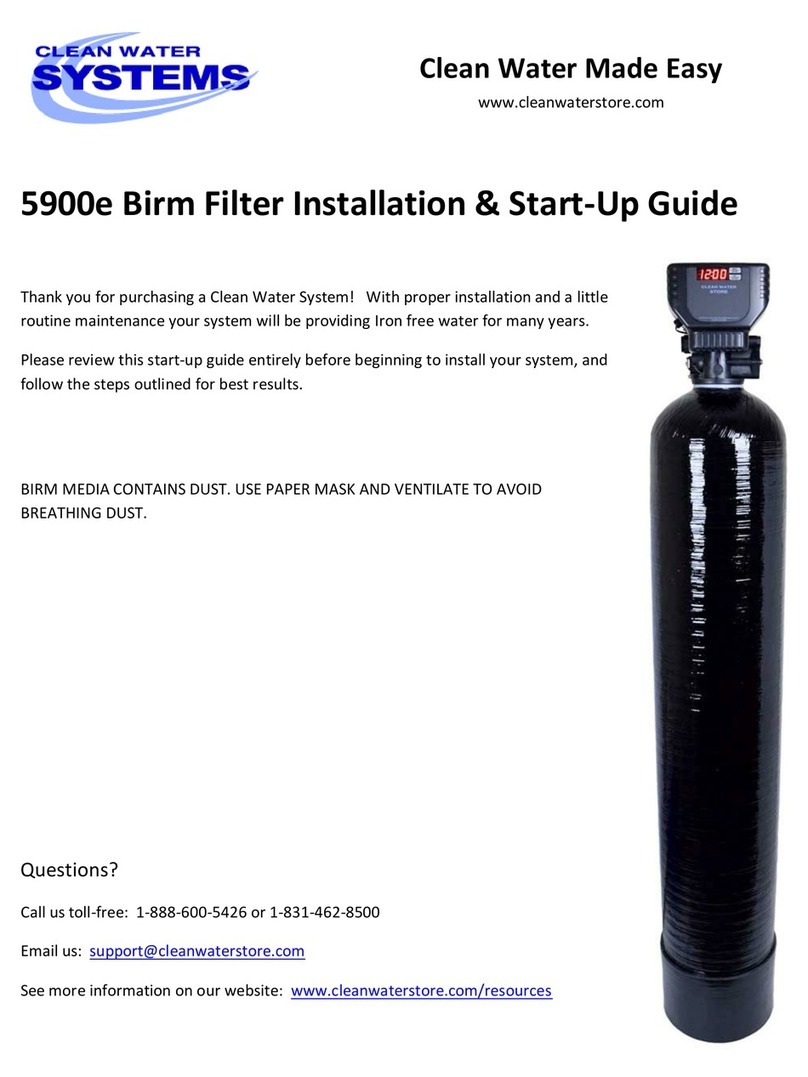
Clean Water Systems
Clean Water Systems Tannin 5900e Series Installation & start?up guide
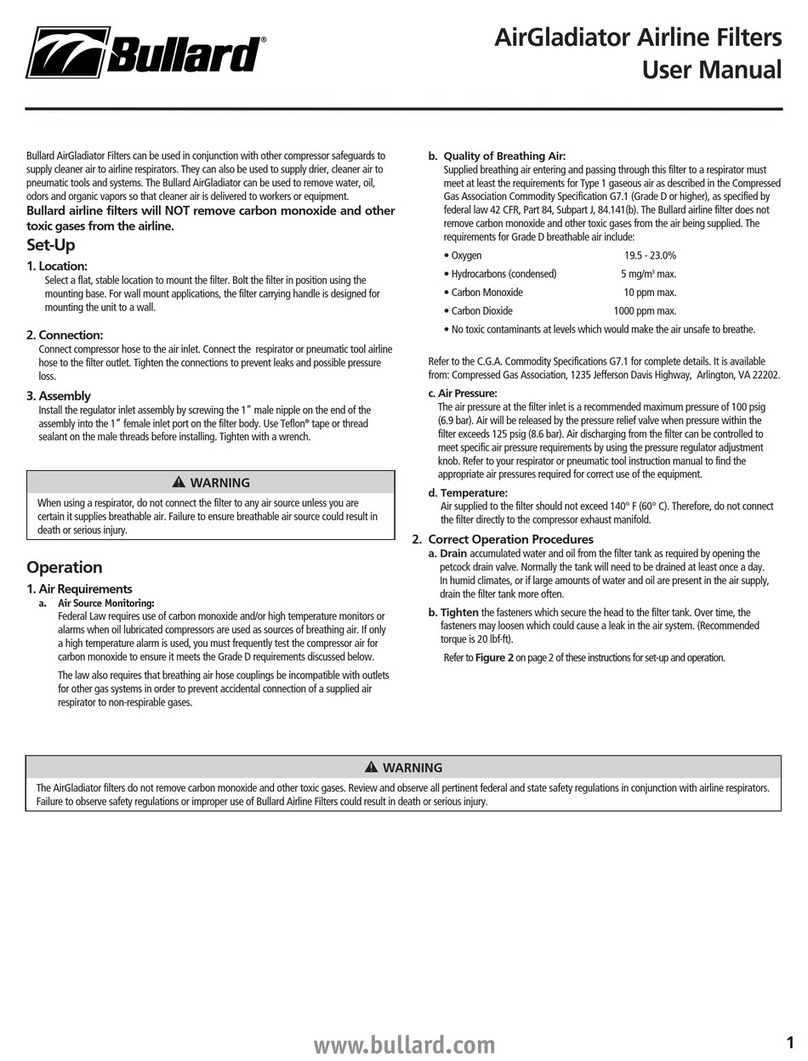
Bullard
Bullard AirGladiator AGLDTR1 user manual

ELECTROSEA
ELECTROSEA ElectroStrainer ES-125 installation manual
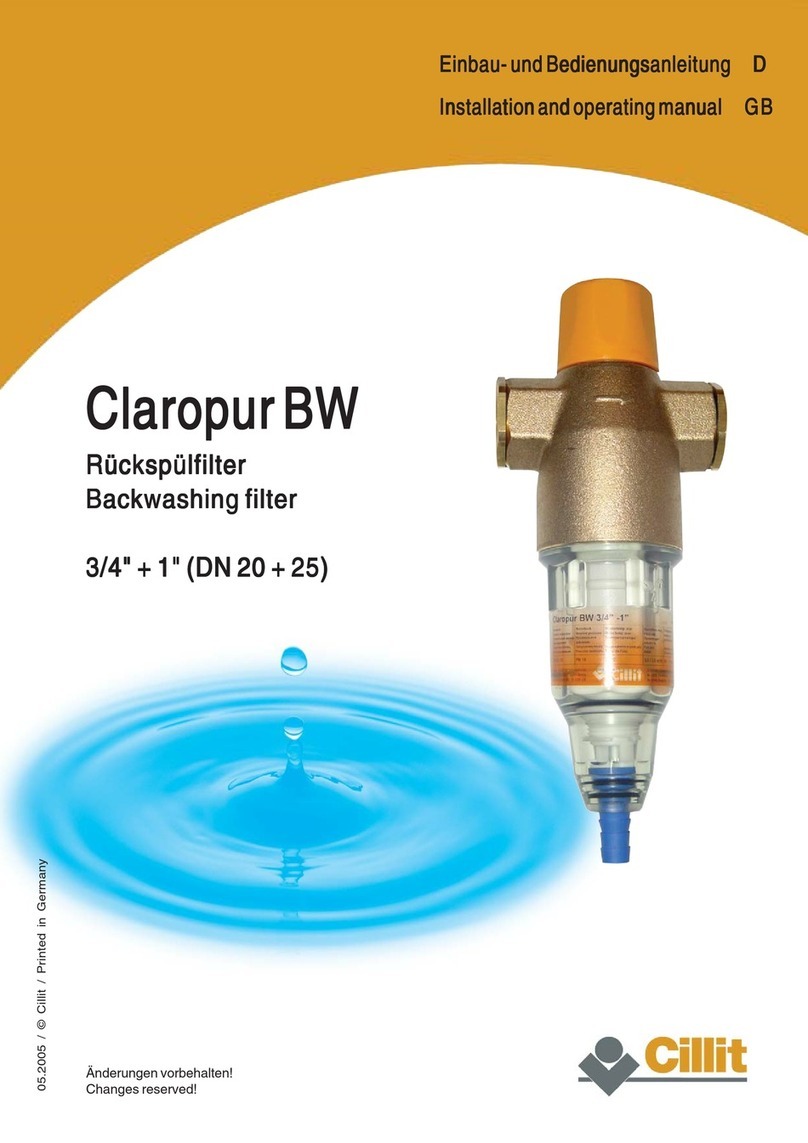
Cillit
Cillit Claropur BW Installation and operating manual
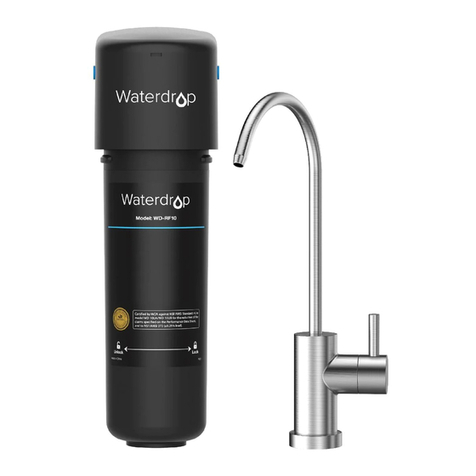
Waterdrop
Waterdrop WD-UB system installation instructions
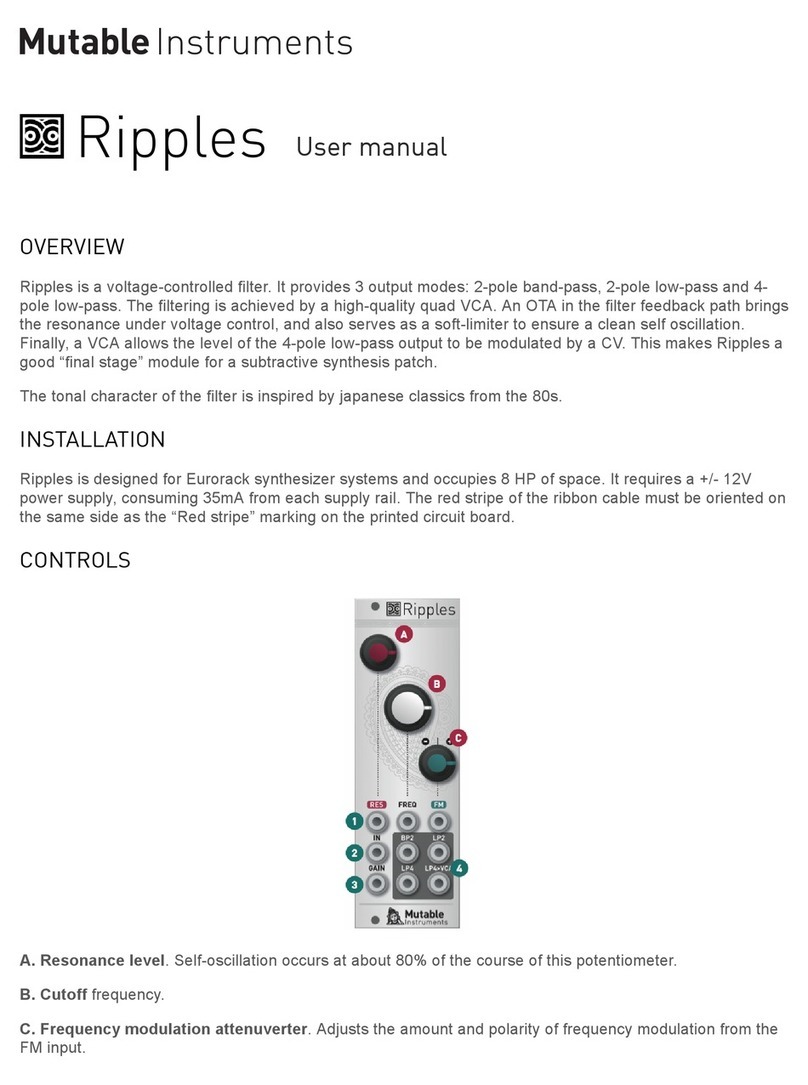
Mutable Instruments
Mutable Instruments Ripples user manual
